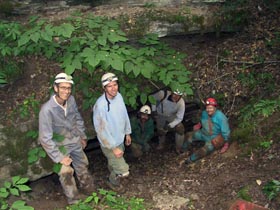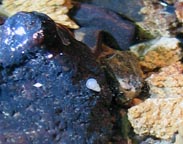To the FWGNA group:
Last month I enjoyed one of the grander adventures of my professional
career, an expedition in search of the (nearly-endemic) cave snail of
southwest Virginia, Holsingeria unthanksensis
(1). The essay that follows is a travelogue of my experiences and
observations. In addition, as an innocent-abroad newly introduced
to cave biology, I picked up a couple unexpected insights of a more
general ecological nature on the expedition, which I humbly offer here for your interest.
Unthanks Cave,
with about 7.3 miles of mapped passages, was purchased by The Nature
Conservancy several years ago and has recently been deeded over to
the Commonwealth of Virginia. The leader of our expedition
was Wil
Orndorff, coordinator of karst protection for the Virginia Department of
Conservation &  Recreation (DCR). There were two other DCR
personnel on the trip with us, Carol Zokaites and Bill Dingus, as well
as Brian Watson and Melanie Stine from the Virginia Department of Game &
Inland Fisheries and myself. Melanie took the photo (at left) of me, Brian, Wil, Bill, and Carol.
Recreation (DCR). There were two other DCR
personnel on the trip with us, Carol Zokaites and Bill Dingus, as well
as Brian Watson and Melanie Stine from the Virginia Department of Game &
Inland Fisheries and myself. Melanie took the photo (at left) of me, Brian, Wil, Bill, and Carol.
The cave is roughly Y-shaped (about as rough as the letter Y could
possibly be) with a base of perhaps 100 meters, a right prong extending
perhaps a mile to pools wherein the Holsingeria dwell, and a left prong extending many miles, intersecting along its course a small underground stream. No Holsingeria were previously known from this left prong.
The six of us entered the cave through a locked gate, descended a rocky
slide, and headed down the right prong about 10:00 one steamy mid-July
morning, half climbing over boulders and half crawling in the
mud. It was real exciting. Some of the wetter rooms
featured lovely stalactites, aprons, flowstones, and all manner of
classic cave formations. But most of the rooms were dry(ish), and
hence the walls and ceilings were bare, although often towering to
great height or falling to inky darkness.
Closer to the mouth of the cave we saw a couple species of very pretty
salamanders and cave crickets with long, spidery legs. As our
journey progressed we saw blind isopods and amphipods, planarians, and
beetles. None of these populations was large - all seemed to be
sparse inhabitants of tiny habitat patches in a vast expanse of black
nothingness.
Around noon we arrived at the end of the right prong of the cave, and a
series of small shallow pools of crystal-clear water. I don't
think there were more than 10-12 such pools, some just a few feet long,
generally no more than a few inches deep. And on the small
cobbles in these pools, if one got on one's knees and made a careful
inspection, very occasionally one could spy tiny white snails no more
than perhaps 4 mm in maximum dimension - Holsingeria unthanksensis. The photo below was taken by Wil.
My first impression was that, surely, this can't be the entire habitat,
nor all the snails. My general experience has led me to expect
hydrobiid populations, especially in springs, to look like grains of
sand on the beach. But I'd guess that the six of us spent 15 - 20
minutes on our knees just observing, and I don't think we saw more than
20 - 30 animals in total. Wil collected three.
I was also impressed, oddly enough, by the shells of dead land snails
scattered about this particular little region of the cave. I do
not know how far we were under the surface at this point, but I don't
think we were very deep. After our initial descent through the
cave mouth our journey was more-or-less horizontal, and occasionally
the ceilings were quite high, 30 meters or more. I should guess
that the energy input to this system comes from fine organic debris
raining from the surface. And I think land snails quite often,
burrowing deeply into the rocky hillside above, slip and plummet to
their deaths on the cave floor below.
 Wil had visited this particular spot on at least two previous
occasions, and his strongest impression was that the water levels were
strikingly low. Southwest Virginia had been suffering a drought
for many weeks, with the Powell River at about 10% of its historic
daily flow. Wil was also surprised not to find any of the second
species of hydrobiid documented from this site, Fontigens nickliniana. Bob Hershler's original description of the environment mentioned that Holsingeria was found together with Fontigens, a much more widespread taxon, locally very common in above-ground springs. Wil had also noticed the Fontigens on his earlier trips. But on this day, no Fontigens were in evidence.
Wil had visited this particular spot on at least two previous
occasions, and his strongest impression was that the water levels were
strikingly low. Southwest Virginia had been suffering a drought
for many weeks, with the Powell River at about 10% of its historic
daily flow. Wil was also surprised not to find any of the second
species of hydrobiid documented from this site, Fontigens nickliniana. Bob Hershler's original description of the environment mentioned that Holsingeria was found together with Fontigens, a much more widespread taxon, locally very common in above-ground springs. Wil had also noticed the Fontigens on his earlier trips. But on this day, no Fontigens were in evidence.
These observations led me to the first of what I should characterize as
an "unexpected revelation." Yes of course, cave environments are
generally more stable than surface environments. But that doesn't
mean that caves don't change. There was plenty of evidence in the
cave of water levels much higher than those we observed - some levels
lasting long enough to form "rimstone" around the pools, and some
levels simply evidenced by damp marks. It can't be too many years before
any such tiny population of aquatic snails must go extinct, right?
We next decided to walk back almost to the entrance of the cave and
explore the left prong, our objective being the small river about a
mile further down this second passage, from which no aquatic gastropods
have ever been observed, by John Holsinger (2) or by anybody else.
It was Wil's hypothesis that snails do not inhabit this river because
the environment is too flashy - perhaps too variable in temperature or
too closely in contact with the surface. But about 10-15 minutes of
searching by four of us did uncover one (individual!) Holsingeria at the left prong river. A range extension!
In fact, Holsingeria unthanksensisis
not endemic to Unthanks Cave. The species has been collected in
at least four other caves scattered about southwest Virginia, with an
enigmatic population (3) documented from Skyline Caverns
as well, perhaps 300 miles north down the Shenandoah Valley.
These caves all lie in Ordovician Limestone that reaches the surface in
ribbons and patches through the ridge and valley province that extends
from Tennessee to Pennsylvania.
So the second "unexpected revelation" I took away from my big adventure
to Unthanks Cave was that what we were doing, essentially, was dropping
a tiny bucket dredge on the bottom of splattery ocean many hundreds of
miles long. My colleagues in the marine biology community
understand that, if they find 30 snails in dredge #1 and zero snails in
dredges #2 - 10, it doesn't mean that the snails were endemic to site
#1, and that their total population size was 30. Rather, they
interpret such data as the consequence of a patchy distribution, the degree of apparent patchiness being a function of sample
volume (4). And the snails may not be rare, nor their extinction
imminent.
Our stalwart party emerged from Unthanks Cave around 4:30 that afternoon,
blinking in the light, baking in the heat, exhausted, muddy, and
sore. What a great day! My special thanks go to Wil Orndorf
(VaDCR) and Brian Watson (VDGIF) for directing and producing this, our
brief peek through a tiny window, into another world.
Keep in touch!
Rob
Notes
(1) Hershler, R. H. (1989) Holsingeria unthanksensis, a new genus and species of aquatic cavesnail from eastern North America. Malac. Rev. 21: 93-100.
(2) I should like to meet Dr. John R. Holsinger,
the cave biologist who first brought Bob Hershler's attention to the
little snails that bear his name. Holsinger, who has a tremendous
reputation in the local caving community, was the primary author of the
cave map Wil used to guide our expedition.
(3) The taxonomic status of the Skyline Caverns snail is unsettled at
this point. Hershler considers it "a probable congener" of H. unthanksensis.
(4) I'm not sure that ecologists are as conscious of sampling as we
once were. My favorite reference on dispersion patterns and
spatial distributions is an older one - Chapter 4 of R. W. Poole's
(1974) Introduction to Quantitative Ecology (McGraw-Hill).
Return ... to the FWGNA front page
 Recreation (DCR). There were two other DCR
personnel on the trip with us, Carol Zokaites and Bill Dingus, as well
as Brian Watson and Melanie Stine from the Virginia Department of Game &
Inland Fisheries and myself. Melanie took the photo (at left) of me, Brian, Wil, Bill, and Carol.
Recreation (DCR). There were two other DCR
personnel on the trip with us, Carol Zokaites and Bill Dingus, as well
as Brian Watson and Melanie Stine from the Virginia Department of Game &
Inland Fisheries and myself. Melanie took the photo (at left) of me, Brian, Wil, Bill, and Carol. Wil had visited this particular spot on at least two previous
occasions, and his strongest impression was that the water levels were
strikingly low. Southwest Virginia had been suffering a drought
for many weeks, with the Powell River at about 10% of its historic
daily flow. Wil was also surprised not to find any of the second
species of hydrobiid documented from this site, Fontigens nickliniana. Bob Hershler's original description of the environment mentioned that Holsingeria was found together with Fontigens, a much more widespread taxon, locally very common in above-ground springs. Wil had also noticed the Fontigens on his earlier trips. But on this day, no Fontigens were in evidence.
Wil had visited this particular spot on at least two previous
occasions, and his strongest impression was that the water levels were
strikingly low. Southwest Virginia had been suffering a drought
for many weeks, with the Powell River at about 10% of its historic
daily flow. Wil was also surprised not to find any of the second
species of hydrobiid documented from this site, Fontigens nickliniana. Bob Hershler's original description of the environment mentioned that Holsingeria was found together with Fontigens, a much more widespread taxon, locally very common in above-ground springs. Wil had also noticed the Fontigens on his earlier trips. But on this day, no Fontigens were in evidence.